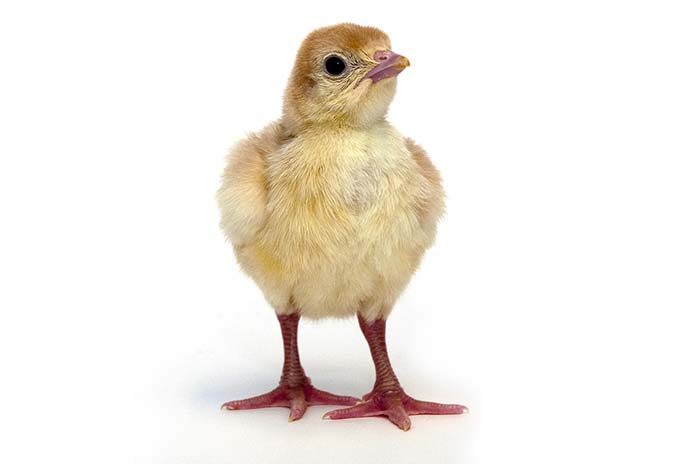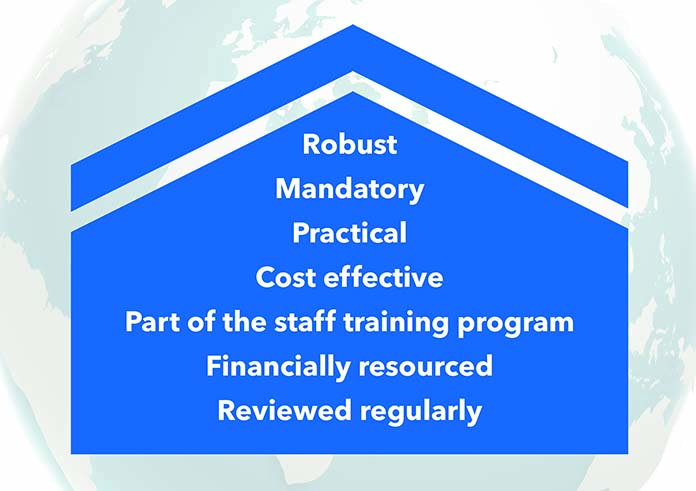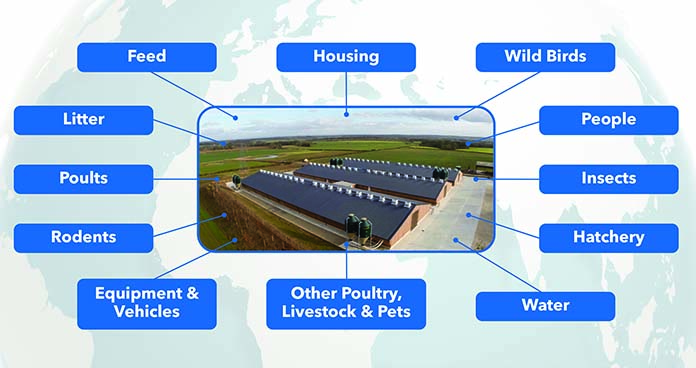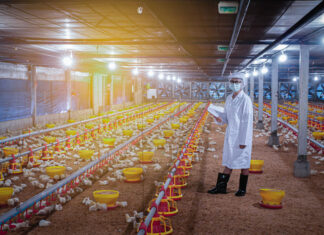
One of the major limiting factors to successful performance in the poultry industry is the impact of disease on poultry production. Effective health strategies focus on the principle that prevention is better than cure. Animal owners have a responsibility to understand and meet the health and welfare needs of their animals. In the poultry sector the prevention of disease not only improves the welfare of the animals, but can also provide economic benefits.
Therefore, the industry must aim at improving the conditions surrounding the birds to prevent disease on a continuous basis. This can only be accomplished by a fully integrated approach, including investments and management improvements.
To achieve this, we advise a system based on several principal pillars. The most important factors contributing are biosecurity; flock health including sourcing of good quality birds, vaccination, gut health, water and feed quality; and the birds’ environment including ventilation, temperature, and litter conditions.
Biosecurity
To safeguard the health of the birds by preventing the introduction and spread of infectious disease causing agents, a strict biosecurity programme must be in place. Biosecurity is the implementation of measures that reduce this risk and requires the adoption of a set of attitudes and behaviours by people to reduce risk in all activities related to poultry production.
An effective biosecurity programme requires the identification of the most likely sources of disease and the establishment of practices designed to prevent the introduction and the spread of these pathogens into and between flocks.
Using the Hazard Analysis and Critical Control Point (HACCP) principle is a helpful tool to identify potential hazards that could occur with regards to disease introduction and following that putting procedures in place to prevent these.
The successful implementation requires considerable technical input. Biosecurity consists of three major components: Isolation, traffic control and sanitation.
Isolation
Production economics usually leads to larger sites and more densely populated poultry areas. These areas present the industry with challenges in preventing the introduction and persistence of disease. Therefore, ever more emphasis needs to be put on the farm’s infrastructure in high-density poultry and/or livestock areas as it is more difficult to achieve isolation of a poultry farm. Isolation is not only important with regards to where the farm is based in the wider geographical area but within the farm itself. Whilst poultry units ideally should be built away from other poultry and livestock units to prevent air and vector borne transmission of disease causing agents onto the site, within the site each house should be seen as a unit in itself to allow the containment of any potential disease issues within a house.
Ideally no open water should be in close proximity to the houses as this is likely to attract waterfowl and increases the risk of the introduction of for example Avian Influenza virus. The same applies for major roads that handle high volumes of poultry business related vehicles such as live haul lorries.
Traffic control
The creation and maintenance of barriers will limit the potential opportunities for contaminated materials to enter an uninfected site. Practices include ‘exclusion’ of visitors, vehicles and equipment that visit other poultry or livestock farms, not sharing staff with other sites and ‘containment’ like isolating houses, controlling rodents and insects, and the entry of wild birds and other animals to the house.
Showering-in and farm-dedicated clothing should be standard on site. Site layout should enable feed to be blown into the bins from outside the perimeter fence, ensuring that feed lorries must not enter the biosecure area.
Sanitation
A part of the programme is the correct use and application of cleansers, sanitizers and disinfectants for both ongoing or terminal cleaning and disinfection procedures. Using a suitable product in the correct way at the right concentration is paramount. Manufacturers are usually willing to advise how to achieve the desired outcome.
Site cleaning must remove all potential poultry and human pathogens and minimise the number of residual bacteria, viruses, parasites, and insects between flocks. It is worth noting that the downtime between flocks is equally crucial to good performance. In this regard it is more important how many days the poultry house is rested under dry and clean conditions than how long the houses are empty. The time depends on the health challenges on the farm and the geographic location.
Pest control
Rodents, wild birds, and insects can carry disease causing agents such as Salmonella Enteritidis and Typhimurium, Avian Influenza and Newcastle Disease, or other viral diseases and Campylobacter, which can contaminate a poultry flock.
Preventing rodents and insects on a farm can be difficult due to plentiful food sources and nesting/breeding sites. Their control requires an integrated pest management programme involving techniques such as rodent-proofing the farm area and houses; eliminating nesting sites and food sources; controlling / eradicating existing populations, and preventing infestations. These control strategies must be carried out continuously to effectively control pests on the farm. The best programmes for preventing or limiting pest populations on the farm utilise biological (elimination of food sources, debris and nesting sites), mechanical (traps, insect light traps) and chemical (rodent baiting, parasiticides and insecticides) controls (these control have to be in accordance with local legislation).
Farm building design should be such as to prevent access for rodents and wild birds. Areas around poultry houses should be kept free from vegetation, debris and equipment, which can provide shelter for rodents. Feed and litter material need to be stored in an inaccessible area for all pests. Prevent nesting of wild birds by eliminating potential nesting sites.
The principles of a good biosecurity program

Flock health
Sourcing
Animal health planning and promotion of best practices are part of effective health strategies. This starts with sourcing good quality day-old birds from healthy breeding stock and a well-managed hatchery.
As breeders can transfer vertically transmitted diseases such as Mycoplasma, as well as beneficial intestinal microbes and immunity via maternal antibodies to their progeny, sourcing day-old birds from healthy breeder flocks which are fed a diet based on good nutrients and have an effective vaccination programme is vital for the adequate development of the embryo and birds in the first few days. Good hatchery management is equally important in producing good quality day-old birds.
Vaccination
The use of a vaccination programme tailored for the location and situation of the flocks can help in the prevention of a range of viral and bacterial disease outbreaks. Where needed, the use of autogenous vaccines which are specifically designed for the individual operation, usually against bacterial infections, can be a good tool to minimize the impact of the pathogens specific to a farm.
Water quality and hygiene
Water quality is often overlooked in poultry production systems. Water is a vital nutrient and can have a negative impact on the birds when it contains high bacterial loads. Whilst feed quality often gets a lot of attention, one needs to bear in mind that poultry will consume around twice as much water during their lifetime as feed. Even if mains water of good quality is used, continuous water sanitation can be required in addition to water line cleaning between flocks. This is because bacteria, fungi or yeasts can quickly re-establish a biofilm in the water system.
A biofilm is an assemblage of microbial cells that is irreversibly associated with a surface and enclosed in a matrix of primarily polysaccharide material which cannot be removed by rinsing alone. Some additive products like vitamins or vaccines provided via water can also create conditions favourable for the growth of biofilms. Mortality is reduced and health greatly improved when this biofilm is removed. Knowledge of methods eliminating and controlling biofilms is essential for effective health strategies. Ideally the build-up of a biofilm is prevented right from the start after cleaning the water lines between flocks.
A daily water sanitation programme will therefore benefit the birds and the water system. Utilisation of disinfectants approved for use in the drinking water of food animals reduces the level of water-borne pathogens and helps to control biofilms. It needs to be kept in mind that poultry can be sensitive to taste and might reduce water intake as a result. During turn-around various sanitation methods are in use and a wider range of line cleaners and biocidal products can be used to treat the water distribution systems.
Nutrition
Over the years the genetic capability of modern poultry breeds has significantly improved as part of a balanced breeding programme. Improved weight gain and efficiency of commercial crosses has resulted in increased growth potential with simultaneous improvement of health, welfare, robustness and sustainability. These well performing birds require nutrients suitable to their increased potential – therefore, while breeds develop, continuous (re)consideration of nutritional and feed management requirements is essential.
Birds must be able to consume enough good quality feed providing all the necessary nutrients to achieve essential physiological organ development. The cardiovascular, respiratory, digestive and immune system development is critical to enable the bird to adequately deal with any possible stressor and give it the best chance to stay healthy. The lack of essential and sufficient nutrients makes a flock more susceptible to disease causing agents.
Gut health
Many factors influence gut health, and consequently performance and susceptibility to infection, in poultry. Good quality feedstuffs are essential for optimum digestibility. Anti-nutritional factors, including the physical form of the feed, impeded accessibility to feed due to high stocking density, nutrient content, and mycotoxins play a role in reducing gut health.
Production programmes need to place great emphasis on avoiding levels of mycotoxins that exceed recommended limits. Producers should be monitoring feed for mycotoxin contamination, and if necessary implement a mycotoxin management programme. Grain damage and conditions that could increase mould and insect spoilage should be minimized. Fats and oils with rancidity should be rejected.
Bacterial contamination of feed and/or water can damage the intestinal tract, leading to an inflammatory response within the intestine that demands increased energy used along with a decreased transit time for the digesta in the intestine. Nutrient availability is then reduced. The outcome of reduced gut health can be diarrhoea leading to wet litter, which in turn can lead to increased footpad lesions in poultry. Diarrhoea can also lead to dirty eggs in laying flocks, which may result in a greater number of eggs being rejected or becoming infected potentially resulting in poor quality chicks.
House environment
Good environmental conditions should be provided in the house for an effective poultry production. Ventilation, temperature, litter management, and stocking density play a part in this.
Any bird not experiencing the right environmental conditions according to its age will be under stress. This can have a negative impact on its feed intake pattern, which can affect intestinal motility, further impacting on gut health and disease resistance. During the brooding period it is important to allow the flock sufficient space. This helps to avoid excessive competition for feed, drink and physical space and helps to give the birds a good start.
Maintaining precise temperature to avoid heat stress or chilling (prevent drafts) and providing the correct ventilation to extract harmful gases and humidity as well as providing oxygen helps to make the bird comfortable and eat properly. Poultry spend their life in close contact with litter material. The aim is to establish good, dry but dust free litter conditions to avoid problems like respiratory disease. High ammonia levels in the air lead to damage of the airway tissues and therefore increased susceptibility to infection.
Conclusions
Effective health strategies revolve around the principle that prevention is better than cure. Animal health planning and promotion of best practices particularly with a focus on biosecurity are at the heart of these strategies. The training of people working at farm and hatchery is crucial. Animals that are cared for appropriately and in accordance with acceptable welfare standards are more likely to be healthy, and less likely to contract or spread disease.
In the poultry sector the prevention of disease not only improves the welfare of the birds, but can also provide economic benefits to the company.
Factors to consider when preparing a biosecurity program













